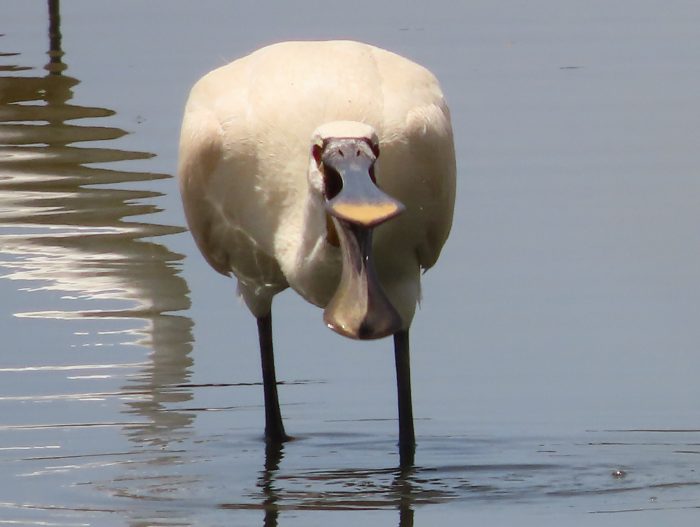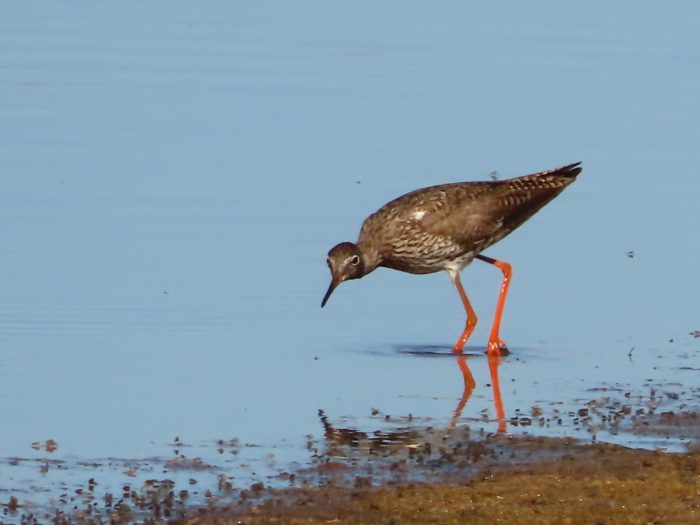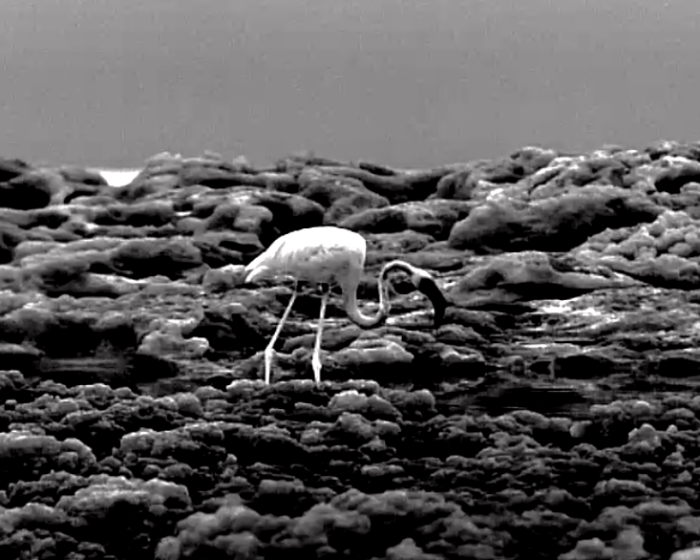On the frontlines is our monthly newsletter section covering the activities of BirdLife Malta’s conservation, policy and nature reserve (Salina, Simar, Għadira and Foresta 2000) teams, together with an update about rare and scarce bird species observed.

Juvenile swift season
In summer you might stumble upon a juvenile swift on the ground. To keep these birds safe until our team picks them up, it is fundamental that you follow a few basic rules.
First, the characteristics and behaviour of a baby swift and a newborn sparrow are immediately distinguishable. Baby sparrows are brown and little, and they are still being fed by their parents on the ground. It is normal for them to wander around during the fledging season, you don’t need to pick them up.
Unlike sparrows, baby swifts are usually greyish, with little black beaks, sharp wingtips on their wings. They also don’t chirp or call for their parents. Since their young cannot take off from the ground, adult swifts will abandon their grounded offspring.
Young swifts often abandon their nests prematurely, either by accident or because of extreme heat. Ensure that the young swift is placed in a cardboard box with ventilation. Water and food are not required because they follow a particular diet, and dietary modifications will be lethal to them. Contact BirdLife Malta at 2134 7645 during business hours or 7925 5697 on weekends and evenings. For further information about injured birds click here.

Stranded Yelkouan Shearwaters
From June to mid-July, young Yelkouan Shearwaters start to depart from their nests located in secluded cliffside areas for the first time. These juvenile seabirds might end up stuck inland on their maiden flight. Light pollution from cities disorientates them at night, as they typically follow the horizon’s light to navigate away from the coast. Unable to return to sea, they often end up stuck on roads, seafronts, ports, towns, and other brightly lit urban areas.
In case you come across a grounded Yelkouan Shearwater, kindly follow our guidelines:
- Contact BirdLife Malta at 2134 7645 during business hours or 7925 5697 on weekends and evenings;
- As precisely as you can, note where you discovered the bird;
- Go around the bird from the back and pick it with a fresh cloth or towel. Do this while holding the wings against the body and controlling the head;
- Put the bird inside a cardboard box with good ventilation;
- Store the box somewhere cold and dark;
- If feasible, provide the bird access to fresh water in a deep container. Give the bird access to the water so it can drink by itself while the box is stationary. Never try to give the bird water on your own;
- Never try to feed the bird yourself.
Gozo flamingo watch
On 18 June, a Greater Flamingo that was spotted in the morning arrived later to the beach of Ras il-Ħobż in Gozo. A team of BirdLife Malta and Malta Ranger Unit (MRU) staff kept watch over the bird throughout the night to ensure its safety. The flamingo had been feeding in the saltwater ponds both during day and night-time, and during the following day, it left the area to continue its migratory journey.
Call for Raptor Camp volunteers
Our conservation team is already preparing for the next autumn hunting season! BirdLife Malta will organise the monitoring of possible illegalities which might occur during the period. We are on the look-out for volunteers willing to participate in our annual Raptor Camp.
The autumn hunting season begins on 1 September and ends on 31 January (both days inclusive), overlapping with the peak of the autumn migration period. From 8 to 23 September, our team will be actively searching for evidence of wildlife crime and reporting incidents to the police for further investigation. This will involve spending long days in the countryside areas of Malta and Gozo, focusing especially on monitoring the most prized and vulnerable species.
If you possess good observational skills, and are comfortable with long days in the field, you can be a great help to our team! Willing and experienced drivers are most welcome.
If you’re interested in joining this year’s Raptor Camp, please email our Conservation Coordinator at [email protected].

Salina Nature Reserve
Sightings
Although as expected, the number of bird species visiting the reserve was very limited in June, there was still a lot to see. The highlight was an adult Greater Flamingo that stayed for a week. Small numbers of waders were present, including Black-winged Stilts, Redshank, Little Ringed Plover, Common Ringed Plover and Common Sandpiper. However, gulls and terns were the predominant species.
Numerous Yellow-legged Gulls were present daily, drinking from the freshwater ponds and resting on the islands. A couple of Mediterranean Gulls and a Black-headed Gull were also regular visitors, along with some Sandwich Terns and a couple of Common Gull-billed Terns. Family parties of Sardinian Warblers, Cetti’s Warblers and Zitting Cisticola enjoyed the freshwater ponds, which offered some respite from the hot and dry June climate.
Spotted Flycatchers were also present in Kennedy Grove area, where they probably bred for the first time.


Works and visits
Work continued to finish the Salt Museum with some more information displays and a new glass showcase. Luckily, we were able to secure the loan of two antique “balance beam weighing scales” that will be on permanent display. These required some work before being placed in the museum.
During the renovation work in the security office, we were shocked to discover wood worm damage in a wooden beam. Normally, this beam is not accessible as it was covered by waterproofing membrane! To address this, the waterproofing and the rotten wood were removed and the beam was treated with appropriate chemicals. However, this job is not finished and needs further attention.
BirdLife Malta was also thrilled to welcome the dedicated staff members of SEP (Malta) Holding Limited for a fantastic CSR activity! The day kicked off with an interesting introduction to Salina’s rich history, culture, and stunning nature. The team then enjoyed an exclusive sneak peek at the Salina Salt Museum, set to open soon! The highlight of the day was when everyone rolled up their sleeves to build nest boxes for the adorable Tree Sparrows!
Għadira Nature Reserve
Sightings
This month’s highlights were the four breeding pairs of Little Ringed Plovers. The first two pairs fledged three chicks each. All juveniles were noted flying between islands. By mid June they were seen flying high above the reserve in strong agile flight. The stone island pair, which were incubating from mid May, hatched four chicks in June. They were all noted feeding and growing throughout the month. Two of the pairs of Little Ringed Plovers were noted incubating towards the end of month.



A variety of interesting birds turned up considering this is usually one of the poorest months of the year. A Eurasian Spoonbill that came at the end of May stayed for a couple of days during the first week of June. A Great White Egret was seen briefly at the reserve on 6 June together with the local flock of 15-20 Little Egrets which visit the reserve daily feeding voraciously on the Mediterranean Killifish. A Common Gull-billed Tern and two Common Redshanks were seen on 14 June while Slender-billed Gulls were also noted frequently. A male black-headed Yellow Wagtail, which is the Balkan race of the Western Yellow Wagtail was also present on various dates.





Works
Summer months bring a variety of maintenance works. The first project on which we focused was the maintenance of the NE perimeter fence. The fence had shade cloth torn at various parts during the winter. New shade cloth was fastened to the fence and tightened with wiring.
Various preparatory works for the birdwatching hide replacement were conducted during most of the month. This included removal of handrails, uprooting and transplanting of plants, removal of three artificial freshwater ponds and removal of panels and signs in the birdwatching hide. Computer data inputting of accumulated bird ringing records was done in June following a busy spring season. Irrigation and filling of ponds was done on a tight schedule as water demands are at the highest during summer.


Simar Nature Reserve
Sightings
In June, bird migration was visibly low with only a handful of migrants still present with most of these during the first week. These included Grey Heron, Sedge Warbler, Collared Sand Martin and Northern House Martin. Other species were present but were also occasionally seen throughout the month such as Turtle-dove and Common Reed-warbler. A few waders also starting arriving and included Little Ringed Plover and Green Sandpiper. A few Black-crowned Night-herons were present throughout the month as well as small numbers of Little Egrets and Collared-doves. The Common Coots were still present but eventually left.
The breeding residents were still carrying out nesting and included Sardinian Warbler, Cetti’s Warbler, Spanish Sparrow and Zitting Cisticola. A good number of Common Moorhens also nested with several family parties observed, as well as a few full-grown juveniles born in the previous months. Some nests were still under incubation.
Works
After several months on hold for most of the habitat management and alteration works, the planned works started being implemented. These interventions will both help reduce visitor impact and at the same time enhance the natural habitat. Shoreline clearing, Tamarisk thinning, alien plant removal, altering parts of the nature path, creating new pathways and creating freshwater pond habitats were some of the initiatives taken.




Foresta 2000
Sightings
By the end of June, visitors at Foresta 2000 could experience the dry land cover of the Mediterranean forest and the strong smells of Mediterranean Thyme and Mustard flowers. Chaste Trees are also in bloom in the steppe valley, providing excellent foraging opportunities for bees. Carob Tree fruits have started turning brown, releasing a beautiful chocolatey smell, and the African Wolfbane has begun producing its silky seeds.
Butterflies were abundant in June, with a variety of species including the Maltese Swallowtail, Common Blue, Large White, and the bright yellow Cleopatra Butterfly. Additionally, different dragonflies, such as the Long Skimmer and Scarlet Darter, were plentiful in the garrigue areas. Plenty of small lizards and chameleons could also be found hiding in the dense vegetation, adding to the diverse wildlife of the area.
As always, summer doesn’t bring many bird sightings. However, loud breeding birds such as Spanish and Tree Sparrows, Sardinian Warblers, and Zitting Cisticolas are always around. Plenty of Collared-doves can be seen gliding overhead. During the morning and evening hours, one can enjoy the flight of Common Swifts. Young Blue Rock-thrushes started flying above the cliffs area after hatching.



Works
Throughout the month, regular weekly clean-ups were conducted, along with some minor repairs to benches in picnic areas and the removal of unstable railings.
Another nature reserves report published!
BirdLife Malta has just published its biennial Managing Land for Nature: Reserve Reports, covering the years 2020–2021. The June 2024 document brings together reports of management works and education at Għadira, Simar, Foresta 2000 and Salina over a two-year period.
Edited by Mark Gauci and Victor Falzon, the 116-page document also includes studies, systematic lists, and bird surveys (ringing, breeding, etc.), as well as a moth survey, a dragonfly update, and a review of the sites’ social media presence. There is also a detailed mapping survey of the vegetation on the islands at Simar, a flora survey of the four sites, and hydrology studies conducted at BirdLife’s nature reserves in the years under review. A new section features BirdLife Malta’s Dinja Waħda Garden initiative. The upkeep of these school sites is partly carried out by BirdLife Malta’s nature reserves staff , and the conservation and educational aims of these gardens are similar to those of our nature reserves, though on a smaller scale.
Closed for summer! Birdlife Malta would like to remind you that our Għadira and Simar Nature Reserves are closed for the summer holidays! Besides there being less birds, it is a time when our breeding birds are given some added protection whilst rearing their young. During the summer months, the reserves’ management teams also take the time to carry out some maintenance work on the sites, improving them both for nature and visitors alike. Come September, and therefore at the onset of autumn migration, we will look forward to welcoming you once more to our sites! Foresta 2000 and Salina remain open throughout the summer.

BirdLife Malta objects to proposed sheep farm in Bidnija
BirdLife Malta objected to a proposed sheep farm in Bidnija (PA/07946/18). This massive building, with multiple levels, reception areas, and a swimming pool, is located within an Outside Development Zone (ODZ) and the buffer zone of Wied Għajn Riħana. This area is listed as a Level 1 Ecological Site in the North West Local Plan (NWLP) policy.
The Wied l-Imselliet and Għajn Riħana valley system holds a freshwater stream for much of the year, including summer. In fact, it serves as a refuge for various wildlife, such as aquatic insects and flora, and providing nesting and resting places for several bird species.
The constructed farm conflicts with several policies, including the NWLP, the Rural Policy Design Guidance and the Strategic Plan for the Environment and Development. The intentions of this development are purely for business, not to strengthen the rural economy and farmer’s income, which are central pillars of the Rural Policy.
BirdLife Malta not only objected to this development but also demanded that the Planning Authority take all necessary action to remove the current structures on site and return the area to its former state. Read our objection here.
New interpretation of building height limitations of Local Plans
The Planning Authority is presenting an amendment to the Development Control Design Policy, Guidance, and Standards (DC15). This new interpretation regarding the height and permissible number of levels suggests that buildings will have more floors than those specified in Local Plans. This trend has already been occurring in recent years. Additional floors imply higher population densities, leading to diminished quality of life for residents. Issues include traffic congestion, noise and air pollution, and sewage overflows.
BirdLife Malta expressed its concerns on environmental impacts, particularly when urban blocks are opposite protected areas and in Outside Development Zones (ODZs). A case in point is Triq il-Pwales facing our Simar Nature Reserve, a protected area within the EU Natura 2000 network. In recent years, Simar has been threatened by the construction of apartment blocks in Triq il-Pwales. These buildings reach up to seven floors, contrary to the four floors specified in the North West Local Plan policy. Light and noise pollution spilling directly over the wetland are of particular concern. This jeopardizes the ecosystem services provided by this protected site.
Ultimately, we advocate for stringent plans for sustainable development. We call for greater efforts to eliminate any impacts on protected sites resulting from urban developments. Read our comments here.

Gull-billed Terns spotted at Għadira and Salina
By the end of May, most spring migratory birds from the African continent to their European summer quarters were already busy raising their young. However, it was still possible to encounter very interesting species visiting during this quieter period. At the end of the month, a scarce Common Gull-billed Tern (Ċirlewwa Bumunqar) graced the sky above Għadira Bay and our Għadira Nature Reserve. It flew elegantly in search of a snack before proceeding elsewhere. This bird is a very scarce and irregular passage migrant in Malta from late March to early June and mid-July to October. It is often seen singly or in small numbers.
A few weeks after the Gull-billed Tern was spotted over Għadira, at the end of June, another two of these beautiful birds were also observed at our Salina Nature Reserve. The Gull-billed Tern is a marsh tern, often seen around mudflats, near the coast and occasionally on beaches. It is a medium-sized tern with a short thick black bill. Body is pale white and the wings are of a pale grey colour with blackish tips. In breeding plumage it attains a black cap on its head but in non-breeding plumage the head is whitish with a pale dark smudge behind the eyes. This tern breeds in several southern European countries, northern Germany and Denmark and around the Black Sea. Watch this video!



Spoonbill visits Għadira…and then Salina
At the beginning of June, a Eurasian Spoonbill (Paletta in Maltese) made a notable appearance at our nature reserves. Initially spotted at Għadira Nature Reserve, the Spoonbill later travelled to Salina Nature Reserve.
The Spoonbill is almost unmistakable. As it name suggests, this magnificent species possesses a large, flat, spatulate bill, which it uses in a distinctive feeding technique. The Spoonbill wades through shallow waters, sweeping its partly-open bill from side to side. Upon contact with any small aquatic creature — be it an insect, crustacean, or tiny fish — the bill snaps shut, securing the meal. Watch the video here.



Credits
Words: Nathaniel Attard, Vera Tokmakova, Justine Borg, Charles Coleiro, Manuel Mallia, David Attard
Photographs: Aron Tanti, Mario V Gauci, Vera Tokmakova, Justine Borg, David Attard, Charles Coleiro, Mauro Spatafora, Manuel Mallia, Martin Austad, BirdLife Malta
Video: Aron Tanti, Mario V Gauci
Editing: Khouloud Belhadj, Nathaniel Attard







